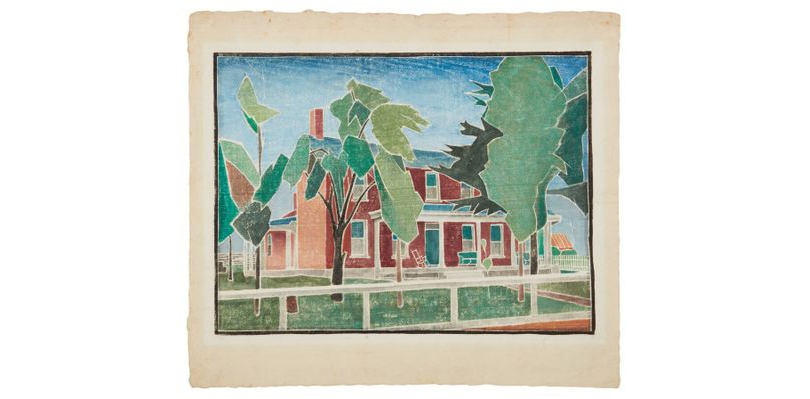WVU TODAY
The Art Museum of West Virginia University announced support from Art Bridges to develop and tour a major exhibition of the work of Blanche Lazzell, one of the most progressive American artists of the first half of the 20th century.
A West Virginia native, Lazzell created some of the earliest abstract paintings in the United States and is one of only 23 artists currently represented in the Whitney Museum of American Art’s “At the Dawn of a New Age: Early Twentieth-Century American Modernism.”
While Lazzell’s role in avant-garde American art is recognized within specialists’ circles, she has not received a major solo exhibition in nearly two decades. The award from Art Bridges allows the Art Museum of West Virginia University to create such an exhibition from its extensive holdings, now increased by the museum’s acquisition of four new works by the artist, including the white line color woodblock print “West Virginia University Farmhouse” (1950).
Established in 2017, the Art Bridges foundation is dedicated to expanding access to American art across the U.S. Art Bridges works with museums of all sizes to provide financial and strategic support to get art out of storage and into communities. The foundation supports arts projects that educate, inspire and deepen engagement with local audiences.
“All of us at the Art Museum of West Virginia University are extraordinarily grateful to Art Bridges for this award,” said Todd Tubutis, the director of the museum. “Blanche Lazzell feels like West Virginia’s best kept secret, but with this support we’ll be able to bring her work to a broader audience. Lazzell played a vital role in American modernism and deserves her due as the radical artist that she was. But perhaps even more importantly, as a woman from West Virginia, she challenges our received narrative about avant-garde artists and who was truly making avant-garde art here in the first half of the 20th century.”
Lazzell (1878–1956) was born and raised near the community of Maidsville, supposedly named for the number of “old maids” in the town. After graduating from WVU with a degree in fine arts in 1905, Lazzell sought further instruction, first enrolling at the Art Students League in New York City and then in the academies and ateliers of Paris, where she studied and associated with Fernand Léger, Andrés Lhote, and Albert Gleizes. Lazzell embraced their influences and created some of the first abstract prints and paintings upon her return to the United States. She is now most associated with the artist colony of Provincetown, Mass., where she eventually settled. There she co-founded the Provincetown Printers and became a leading figure in white-line color woodblock printmaking.
Lazzell is perhaps best known for these woodblock prints but she was also a prolific painter who experimented with various themes and subjects across media throughout her career. Her work has been included in many notable national and international exhibitions over the course of her lifetime, and posthumous exhibitions have been organized by the Boston Museum of Fine Arts, the Archives of American Art, and at West Virginia University. Other major institutions with holdings of Lazzell’s art include the Brooklyn Museum, Crystal Bridges of American Art, Metropolitan Museum of Art, Smithsonian American Art Museum and Whitney Museum of American Art.
The Art Bridges funding supports the development of “Blanche Lazzell: Becoming an American Modernist,” the most comprehensive exhibition devoted to the artist to date. This exhibition centers on a suite of large-scale abstract paintings she made in the 1920s that were among the most ambitious paintings for any American at the time.
The exhibition is designed to introduce Lazzell’s groundbreaking work to a broad audience, to assert that Lazzell’s advanced thinking interrogates the existing modernist canon, and to offer visitors an onramp into artistic abstraction. Including more than 50 paintings, prints and works on paper drawn primarily from the Art Museum of West Virginia University’s permanent collection, “Blanche Lazzell: Becoming an American Modernist” explores the artist’s lifelong pursuit of translating modernism into an American art form and celebrates her largely unsung achievements in creating and championing abstract art in the United States.
“West Virginia University Farmhouse” is an example of the artist’s signature white line color woodblock print technique. This image is of the Vance Farmhouse — built in 1854, acquired by the university in 1899 and now the home of the WVU Press.




